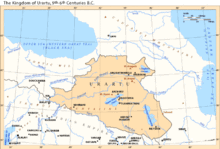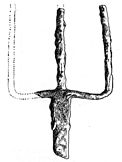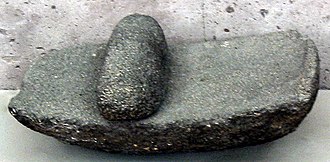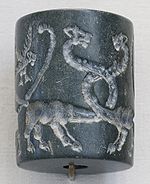அரராத்து இராச்சியம்: திருத்தங்களுக்கு இடையிலான வேறுபாடு
சி →top |
சி →top |
||
| வரிசை 1: | வரிசை 1: | ||
[[File:13-Urartu-9-6mta.gif|thumb|அரராத்து இராச்சியத்தின் அமைவிடம்]] |
[[File:13-Urartu-9-6mta.gif|thumb|அரராத்து இராச்சியத்தின் அமைவிடம்]] |
||
'''உரார்த்து இராச்சியம்''' ('''Urartu''') ({{IPAc-en|ʊ|ˈ|r|ɑr|t|uː}}), [[விவிலியம்]] கூறும் [[அரராத்து (விவிலியம்)|அரராத்து மலைகளை]] மையமாகக் கொண்ட இராச்சியம் ஆகும். தற்கால [[ஆர்மீனியா]]வின் மேட்டு நிலங்களில் வளர்ந்த அரராத்து இராச்சியத்தின் [[ஹுரியத் மக்கள்]], தற்கால [[ஆர்மீனியா]], [[அசர்பைஜான்]], [[ஜார்ஜியா]], [[ஈரான்]], [[ஈராக்]] மற்றும் [[துருக்கி]] நாடுகளின் பகுதிகளை கிமு 858 முதல் கிமு 590 முடிய 268 ஆண்டுகள் ஆண்டனர்.<ref>F. W. König, ''Handbuch der chaldischen Inschriften'' (1955).</ref> |
'''உரார்த்து இராச்சியம்''' ('''Urartu''') ({{IPAc-en|ʊ|ˈ|r|ɑr|t|uː}}), [[விவிலியம்]] கூறும் [[அரராத்து (விவிலியம்)|அரராத்து மலைகளை]] மையமாகக் கொண்ட இராச்சியம் ஆகும். தற்கால [[ஆர்மீனியா இராச்சியம்|ஆர்மீனியா]]வின் மேட்டு நிலங்களில் வளர்ந்த அரராத்து இராச்சியத்தின் [[ஹுரியத் மக்கள்]], தற்கால [[ஆர்மீனியா]], [[அசர்பைஜான்]], [[ஜார்ஜியா]], [[ஈரான்]], [[ஈராக்]] மற்றும் [[துருக்கி]] நாடுகளின் பகுதிகளை கிமு 858 முதல் கிமு 590 முடிய 268 ஆண்டுகள் ஆண்டனர்.<ref>F. W. König, ''Handbuch der chaldischen Inschriften'' (1955).</ref> |
||
அரராத்து இராச்சியத்தின் நிலப்பரப்புகள் மேற்கில் [[அனதோலியா]] மற்றும் [[மெசொப்பொத்தேமியா]]வும், கிழக்கில் [[ஈரானியப் பீடபூமி]], [[காக்கசஸ் மலைத்தொடர்|ஆர்மீனியன் மேட்டு நிலங்களைக்]] கொண்டது. அரராத்து இராச்சியத்தின் தென்மேற்கில் [[புது பாபிலோனியப் பேரரசு]]ம், தெற்கில் [[மீடியாப் பேரரசு]]ம் இருந்தது. |
அரராத்து இராச்சியத்தின் நிலப்பரப்புகள் மேற்கில் [[அனதோலியா]] மற்றும் [[மெசொப்பொத்தேமியா]]வும், கிழக்கில் [[ஈரானியப் பீடபூமி]], [[காக்கசஸ் மலைத்தொடர்|ஆர்மீனியன் மேட்டு நிலங்களைக்]] கொண்டது. அரராத்து இராச்சியத்தின் தென்மேற்கில் [[புது பாபிலோனியப் பேரரசு]]ம், தெற்கில் [[மீடியாப் பேரரசு]]ம் இருந்தது. |
||
| வரிசை 7: | வரிசை 7: | ||
இவ்விராச்சிய மக்கள் [[ஆப்பெழுத்து|ஆப்பெழுத்து முறையில்]] எழுதப்பட்ட உரார்த்து மொழி பேசினர்.<ref name="Diakonoff 1992 51–54" /><ref name="andrastas">Róna-Tas, András.''Hungarians and Europe in the Early Middle Ages: An Introduction to Early Hungarian History''. Budapest: Central European University Press, 1999 p. 76 {{ISBN|963-9116-48-3}}.</ref><ref>{{cite journal|last=Greppin|first=John A. C.|title=Some Effects of the Hurro-Urartian People and Their Languages upon the Earliest Armenians|journal=Journal of the American Oriental Society|year=1991|volume=3|issue=4|pages=720–730|quote=Even for now, however, it seems difficult to deny that the Armenians had contact, at an early date, with a Hurro-Urartian people.|doi=10.2307/603403}}</ref><ref name="chahin">{{cite book|last=Chahin|first=M.|title=The kingdom of Armenia: a history|year=2001|publisher=Curzon|location=Richmond|isbn=0700714529|page=182|url=https://books.google.com/books?id=OR_PHoKZ6ycC|edition= 2nd revised}}</ref><ref>{{cite book|last=Scarre|first=edited by Chris|title=Human past : world prehistory and the development of human societies.|year=2013|publisher=W W Norton|isbn=0500290636|url=https://books.google.com/books?id=dKXYMQEACAAJ|edition= 3rd}}</ref> |
இவ்விராச்சிய மக்கள் [[ஆப்பெழுத்து|ஆப்பெழுத்து முறையில்]] எழுதப்பட்ட உரார்த்து மொழி பேசினர்.<ref name="Diakonoff 1992 51–54" /><ref name="andrastas">Róna-Tas, András.''Hungarians and Europe in the Early Middle Ages: An Introduction to Early Hungarian History''. Budapest: Central European University Press, 1999 p. 76 {{ISBN|963-9116-48-3}}.</ref><ref>{{cite journal|last=Greppin|first=John A. C.|title=Some Effects of the Hurro-Urartian People and Their Languages upon the Earliest Armenians|journal=Journal of the American Oriental Society|year=1991|volume=3|issue=4|pages=720–730|quote=Even for now, however, it seems difficult to deny that the Armenians had contact, at an early date, with a Hurro-Urartian people.|doi=10.2307/603403}}</ref><ref name="chahin">{{cite book|last=Chahin|first=M.|title=The kingdom of Armenia: a history|year=2001|publisher=Curzon|location=Richmond|isbn=0700714529|page=182|url=https://books.google.com/books?id=OR_PHoKZ6ycC|edition= 2nd revised}}</ref><ref>{{cite book|last=Scarre|first=edited by Chris|title=Human past : world prehistory and the development of human societies.|year=2013|publisher=W W Norton|isbn=0500290636|url=https://books.google.com/books?id=dKXYMQEACAAJ|edition= 3rd}}</ref> |
||
உரார்த்து இராச்சியம் கிமு ஆறாம் நூற்றாண்டின் இறுதியில் வீழ்ச்சி அடைந்து கொண்டிருந்த நேரத்தில், பாரசீகத்தின் [[மீடியாப் பேரரசு|மீடியாப் பேரரசினர்]] கிமு 590ல் அரராத்து இராச்சியத்தை முழுவதுமாகக் கைப்பற்றினர். தற்கால ஆர்மினிய மக்களின் முன்னோர்கள் உரார்த்து மொழி பேசியவர்கள் எனக்கருதப்படுகிறது.<ref name=chahin /><ref name=richard>{{cite book|last=Frye|first=Richard N.|title=The History of Ancient Iran|year=1984|publisher=C.H. Beck|location=Munich|isbn=3406093973|page=73|url=https://books.google.com/books?id=0y1jeSqbHLwC|quote=The real heirs of the Urartians, however, were neither the Scythians nor Medes but the Armenians.}}</ref><ref>{{cite book|last=Redgate|first=A. E.|title=The Armenians|year=2000|publisher=Blackwell|location=Oxford|isbn=0631220372|page=5|url=https://books.google.com/books?id=e3nef10a3UcC&dq|quote=However, the most easily identifiable ancestors of the later Armenian nation are the Urartians.}}</ref><ref name=dlang>{{cite book|last=Lang|first=David Marshall|title=Armenia: Cradle of Civilization|year=1980|publisher=Allen & Unwin|location=London|isbn=0049560093|pages=85–111|url=https://books.google.com/books?id=HG4MAQAAMAAJ|edition= 3rd}}</ref> |
|||
==அரராத்து இராச்சியத்தின் ஆட்சியாளர்கள்== |
==அரராத்து இராச்சியத்தின் ஆட்சியாளர்கள்== |
||
15:44, 27 அக்டோபர் 2019 இல் நிலவும் திருத்தம்

உரார்த்து இராச்சியம் (Urartu) (/ʊˈrɑːrtuː/), விவிலியம் கூறும் அரராத்து மலைகளை மையமாகக் கொண்ட இராச்சியம் ஆகும். தற்கால ஆர்மீனியாவின் மேட்டு நிலங்களில் வளர்ந்த அரராத்து இராச்சியத்தின் ஹுரியத் மக்கள், தற்கால ஆர்மீனியா, அசர்பைஜான், ஜார்ஜியா, ஈரான், ஈராக் மற்றும் துருக்கி நாடுகளின் பகுதிகளை கிமு 858 முதல் கிமு 590 முடிய 268 ஆண்டுகள் ஆண்டனர்.[1]
அரராத்து இராச்சியத்தின் நிலப்பரப்புகள் மேற்கில் அனதோலியா மற்றும் மெசொப்பொத்தேமியாவும், கிழக்கில் ஈரானியப் பீடபூமி, ஆர்மீனியன் மேட்டு நிலங்களைக் கொண்டது. அரராத்து இராச்சியத்தின் தென்மேற்கில் புது பாபிலோனியப் பேரரசும், தெற்கில் மீடியாப் பேரரசும் இருந்தது.
இவ்விராச்சிய மக்கள் ஆப்பெழுத்து முறையில் எழுதப்பட்ட உரார்த்து மொழி பேசினர்.[2][3][4][5][6]
உரார்த்து இராச்சியம் கிமு ஆறாம் நூற்றாண்டின் இறுதியில் வீழ்ச்சி அடைந்து கொண்டிருந்த நேரத்தில், பாரசீகத்தின் மீடியாப் பேரரசினர் கிமு 590ல் அரராத்து இராச்சியத்தை முழுவதுமாகக் கைப்பற்றினர். தற்கால ஆர்மினிய மக்களின் முன்னோர்கள் உரார்த்து மொழி பேசியவர்கள் எனக்கருதப்படுகிறது.[5][7][8][9]
அரராத்து இராச்சியத்தின் ஆட்சியாளர்கள்

- அரமு - கிமு 858–844
- முதலாம் சர்துரி - கிமு 844–828
- இஷ்புய்னி - கிமு 828–810
- மெனுவா - கிமு 785–753
- முதலாம் அர்கிஷ்தி - கிமு 828–810
- இரண்டாம் சர்துரி - கிமு 753–735
வேளாண்மை
புது அசிரியப் பேரரசில் கையாண்ட வேளாண் முறையே அரராத்து இராச்சியதிலும் கையாளப்பட்டது. போர்க் கைதிகளை தொழிலாளர்களாக பயன்படுத்தினர். தானியங்கள், குதிரைகள், காளைகள் முதலியன வரியாக அரசுக்கு செலுத்தினர். அமைதிக் காலங்களில் அரராத்து வணிகர்கள், அசிரியர்களுடன் மது, இரும்பு, குதிரைகள் மற்றும் கால்நடைகளை பண்டமாற்று முறையில் வணிகத்தில் ஈடுபட்டனர்.
 |
 |
 | ||
| வேளாண் கருவிகள் | அம்மியும், குழவியும் | |||
அரராத்து இராச்சியத்தின் தொல்பொருட்கள்
அகழாய்வில் கண்டெடுக்கப்பட்ட அரராத்து இராச்சிய தொல்பொருட்கள்:
-
கிமு 8ம் நூற்றாண்டின் காளையின் தலை
-
இறக்கைகள் கொண்ட தேவதை
-
அரராத்து மக்களின் ஹல்தி கடவுள்
-
ஆப்பெழுத்து முறையில் எழுத்தப்பட்ட அரராத்து மொழிக் கல்வெட்டு
இதனையும் காண்க
- அக்காடியப் பேரரசு
- ஹுரியத் மக்கள்
- மத்திய அசிரியப் பேரரசு
- புது அசிரியப் பேரரசு
- மத்திய அசிரியப் பேரரசு
- மீடியாப் பேரரசு
- மெசொப்பொத்தேமியா
- புது பாபிலோனியப் பேரரசு
மேற்கோள்கள்
- ↑ F. W. König, Handbuch der chaldischen Inschriften (1955).
- ↑ பிழை காட்டு: செல்லாத
<ref>குறிச்சொல்;Diakonoff 1992 51–54என்னும் பெயரில் உள்ள ref குறிச்சொல்லுக்கு உரையேதும் வழங்கப்படவில்லை - ↑ Róna-Tas, András.Hungarians and Europe in the Early Middle Ages: An Introduction to Early Hungarian History. Budapest: Central European University Press, 1999 p. 76 ISBN 963-9116-48-3.
- ↑ Greppin, John A. C. (1991). "Some Effects of the Hurro-Urartian People and Their Languages upon the Earliest Armenians". Journal of the American Oriental Society 3 (4): 720–730. doi:10.2307/603403. "Even for now, however, it seems difficult to deny that the Armenians had contact, at an early date, with a Hurro-Urartian people.".
- ↑ 5.0 5.1 Chahin, M. (2001). The kingdom of Armenia: a history (2nd revised ). Richmond: Curzon. பக். 182. பன்னாட்டுத் தரப்புத்தக எண்:0700714529. https://books.google.com/books?id=OR_PHoKZ6ycC.
- ↑ Scarre, edited by Chris (2013). Human past : world prehistory and the development of human societies. (3rd ). W W Norton. பன்னாட்டுத் தரப்புத்தக எண்:0500290636. https://books.google.com/books?id=dKXYMQEACAAJ.
- ↑ Frye, Richard N. (1984). The History of Ancient Iran. Munich: C.H. Beck. பக். 73. பன்னாட்டுத் தரப்புத்தக எண்:3406093973. https://books.google.com/books?id=0y1jeSqbHLwC. "The real heirs of the Urartians, however, were neither the Scythians nor Medes but the Armenians."
- ↑ Redgate, A. E. (2000). The Armenians. Oxford: Blackwell. பக். 5. பன்னாட்டுத் தரப்புத்தக எண்:0631220372. https://books.google.com/books?id=e3nef10a3UcC&dq. "However, the most easily identifiable ancestors of the later Armenian nation are the Urartians."
- ↑ Lang, David Marshall (1980). Armenia: Cradle of Civilization (3rd ). London: Allen & Unwin. பக். 85–111. பன்னாட்டுத் தரப்புத்தக எண்:0049560093. https://books.google.com/books?id=HG4MAQAAMAAJ.
வெளி இணைப்புகள்
- Livius History of Urartu/Armenia
- Historical Maps of Urartu at WikiMedia Commons
- An Urartian Ozymandias – article by Paul Zimansky, Biblical Archaeologist
- Urartu Civilization
- Urartu (Greek Ararat)
- Capital and Periphery in the Kingdom of Urartu, Yehuda Dagan, Israel Antiquities Authority








